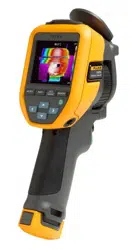Loading ...
Loading ...
Loading ...

TiS55+/TiS75+
Users Manual
14
The scale along the right side of the display shows the thermal span increasing or
decreasing in size and shows the span as it moves to different levels within the total range.
See Table 9.
To use the temperature range high and low values on the display for future measurements:
1. Set Level/Span to Manual.
2. Push a to rescale the display and save the temperature values on the display at that
time.
To use a different temperature range, use the arrow keys to change the Level/Span, or
push a twice to rescale.
Note
The Imager always powers up in the same Level/Span mode, Auto or Manual, as
when the Imager was powered down.
Emissivity Adjustment
All objects radiate infrared energy. The actual surface temperature and emissivity of the
target affects the quantity of energy radiated. The Imager senses the infrared energy from
the surface of the target and uses the data to calculate an estimated temperature value.
Many common materials such as wood, water, skin, cloth, and painted surfaces, including
metal, radiate energy well and have a high emissivity factor of ≥90 % (or 0.90). The Imager
measures temperatures accurately on targets with a high emissivity.
Shiny surfaces or unpainted metals do not radiate energy well and have a low emissivity
factor of <0.60. For the Imager to calculate a more accurate estimate of the actual
temperature of targets with a low emissivity, adjust the emissivity setting.
W Warning
To prevent personal injury, see emissivity information for actual temperatures.
Reflective objects result in lower than actual temperature measurements.
These objects pose a burn hazard.
Set emissivity as a direct value or from a list of emissivity values for some common
materials. If the emissivity value is <0.60, a caution shows on the display.
Note
Surfaces with an emissivity of
<
0.60 make it difficult to determine reliable and
consistent actual temperatures. The lower the emissivity, the greater the potential of
error when the Imager calculates the temperature measurement because more of
the energy reaching the camera is specified as background temperature. This is also
true even when adjustments to the emissivity and reflected background adjustments
are performed properly.
1.888.610.7664 sales@GlobalTestSupply.com
Fluke-Direct.com
Loading ...
Loading ...
Loading ...
